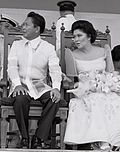MV Karagatan incident
 MV Karagatan hits a rock while on waters off Digoyo Point | |
| Date | July 4, 1972 |
|---|---|
| Location | Digoyo Point, Palanan, Isabela, Philippines |
| Coordinates | 16°55′00.6″N 122°27′48.5″E / 16.916833°N 122.463472°ECoordinates: 16°55′00.6″N 122°27′48.5″E / 16.916833°N 122.463472°E |
| Type | Arms trafficking |
| Motive | Arms trafficking for the New People's Army for use in the Communist rebellion in the Philippines |
| Participants | |
| Outcome | Arms shipment intercepted by the Philippine military; MV Karagatan sank and crew abandoned ship |
| Property damage | MV Karagatan (sank) |
The MV Karagatan incident involved an attempt to smuggle in armaments to the Philippines from China by the New People's Army, a communist rebel group through a ship named MV Karagatan. The incident is among the reasons used by President Ferdinand Marcos when he imposed Martial law in the Philippines on September 21, 1972.
Background and planning[]
Jose Maria Sison the founder of the Communist Party of the Philippines (CPP) requested foreign aid from China for military and monetary support for the New People's Army (NPA), the CPP's armed wing. Sison secured support from Mao Zedong, the Chairman of the Chinese Communist Party[1] At that time, China actively provides arms to North Vietnam and other left-aligned Third World countries.[2] The CPP-NPA requested for a submarine from China, but such request was rejected. Instead, China agreed to fund the purchase of a ship that would transports arms into the Philippines for use of the NPA. Sison sent Fidel Agcaoili to Japan to purchase an old 91-ton, 27.43 metres (90.0 ft) steel hulled fishing trawler which was known as the Kishi Maru. Kishi Maru was rechristened as MV Karagatan. The MV Karagatan went to Fukien (modern-day Fujian) where it was loaded with cargo which included 1,400 firearms which is intended to be smuggled into the Philippines. It left China by the end of June 1972.[3]
Arms landing[]
The MV Karagatan reached the Digoyo Point in Palanan, Isabela, Philippines. On July 4, 1972, the crew of the ship boarded a dinghy and met with their NPA contacts along the shore.[3] Victor Corpus, a defector from the Philippine military and a member of the NPA at the time, was tasked to led the group that would receive the armaments at shore.[4]
Then the arms on board the MV Karagatan were then slowly unloaded using multiple bangka. A small plane passed over the area which prompted the MV Karagatan crew to move their ship closer to the mouth of the Digoyo River thinking they have been found out by the Philippine military. Another plane flew over the area at sunset, which was identified by the crew as a T-34 Mentor. This led to the ship captain to start the engine causing the MV Karagatan's hydraulic system to sustain damage after hitting a rock. While the ship undergoing repairs, the captain turned on the radar and spotted an unidentified vessel moving towards the boat. The crew abandoned the ship and headed towards the shore.[3]
Aftermath[]
The crew of the MV Karagatan escaped to the Sierra Madre to meet up with the NPA with the help of a Dumagat guide. The Philippine military was able to intercept the armaments.[3] The MV Karagatan also sank to the bottom of the sea.[4] The arms landing incident was used a justification for President Ferdinand Marcos to imposed Martial law over the Philippines on September 21, 1972, although it was not the sole reason.[5] Among the other reasons were the 1971 Plaza Miranda bombing[2] and the 1972 ambush of then Defense Secretary Juan Ponce Enrile; an event which Enrile said to be staged when he led the 1986 People Power Revolution which deposed Marcos but retracted the claim in a 2012 memoir he wrote.[5]
The MV Karagatan incident was followed by another arms trafficking attempt. The NPA procured another ship which was named as MV Andrea. However the ship sank in the South China Sea on its way to Sanya Naval Base in Hainan to load hundreds of firearms concealed inside plastic tubes.[2]
China and the Philippines formally established diplomatic relations on June 9, 1975, which marks the end of Chinese support for the NPA.[2]
In popular culture[]
The MV Karagatan incident was the subject of the 2012 documentary "Ang Pagbabalik sa Karagatan" (transl. "The Return to the Ocean") by Howie Severino, which was aired on GMA Network's IWitness. In the documentary, a crew led by Severino along with former NPA commander Victor Corpus went to Digoyo Point to visit the shipwreck of MV Karagatan.[2][6]
References[]
- ^ Peña, Rolando (December 11, 2018). "How one ship might have changed the course of the Marcos Regime". ABS-CBN News. Retrieved May 2, 2021.
- ^ a b c d e Dacanay, Barbara Mae (August 10, 2012). "Ex-communist leader gets sentimental as divers find sunken ship". Gulf News. Retrieved May 3, 2021.
- ^ a b c d Peña, Rolando (December 12, 2018). "The NPA arms landing that convinced Marcos to declare Martial Law". ABS-CBN News. Retrieved May 2, 2021.
- ^ a b "Untold story of Karagatan in I-Witness". The Philippine Star. July 30, 2018. Retrieved May 2, 2021.
- ^ a b "Vera Files Fact Check: 1972 MV Karagatan incident NOT sole reason for martial law declaration". Vera Files. June 24, 2020. Retrieved May 2, 2021.
- ^ "'Ang Pagbabalik sa Karagatan', a documentary by Howie Severino". GMA News (in Tagalog). GMA Public Affairs. July 27, 2021. Retrieved May 2, 2021.
- Communist armed conflicts in the Philippines
- History of the Philippines (1965–1986)
- Military history of the Philippines
- Arms trafficking
- China–Philippines relations
- 1972 crimes in the Philippines

